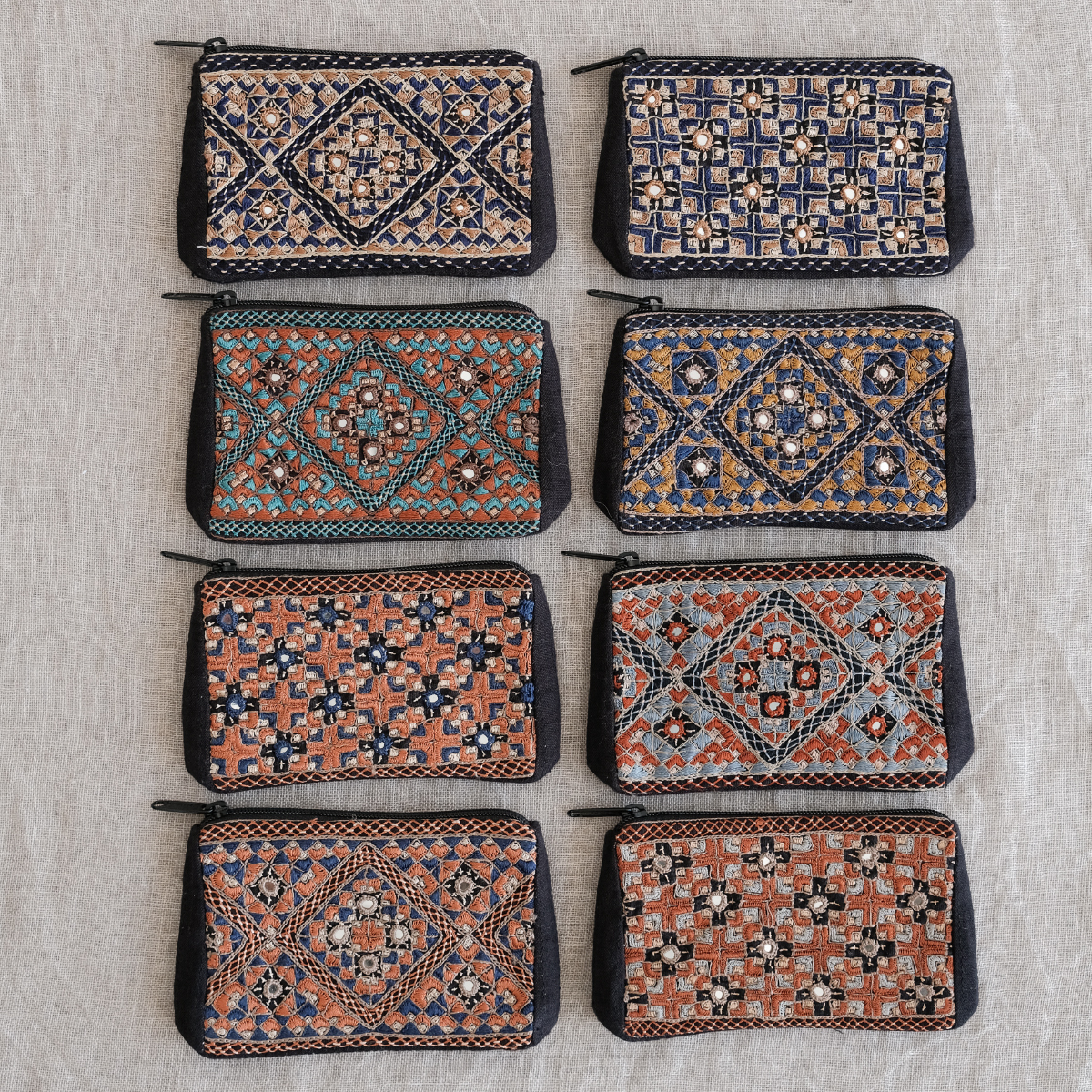It Sparkles in Your Hand – Embroidered Accessories

Like Stitched Jewelry ...
They know the genius of sparkle and colour. They can embellish any cloth with only a needle, thread, and imagination. They are brilliant craftspeople who carry artisan stitch-traditions into the future.
Traditional embroidery has always had a role in the world. It has always been a visual statement of skill. It has always been an expression of beauty. It has always worked to transform a plain piece of cloth into something extraordinary.
Maiwa has collaborated with tribal embroiderers to bring the most skillful work into being. These all have one thing in common. They were designed to showcase needlework in a way that can be used on a daily basis.
Stitch Recognition
Can you spot a stitch? We work with a number of distinct embroidery communities. Each one has a vocabulary of pattern, stitch and thread. Each one speaks in a beautifully embroidered voice, but each one is different: Like voices speaking the same language in different dialects.
Let's meet the groups ...
The Sodha Rajput community used to live in Sindh, Pakistan but have now mostly migrated to Kachchh, India. They are primarily farmers but with their migration from Sindh as late as 1971 during the Indo-Pakistan war, they have been left with some of the least fertile land. They brought with them their embroidery skills, and most importantly their exceptional repertoire of designs. Sodha embroidery is detailed and often based on the repetition and variation of square elements within this geometric field they will often find ways to introduce curvilinear lines and tiny flowers, birds, animals and figurative motifs.


The embroidery of the Dhebaria Rabari (a tribal group living in Kachchh, India) is a distinct combination of stitch and appliqué. The aesthetic is immediately recognizable and unlike the work of any other group. They delight in abstract representations that are variously claimed to be peacocks, birds, and flowers. Lines and figures done in wandering stitchwork are alsounique to this group.
The Node community are Muslim and are found primarily in the grasslands of Kachchh, India – however some also live in Sindh, Pakistan. The Node are a community of cattle breeders and farmers and are most often landless. The women in the community are highly skilled embroiderers and embroidery is an integral part of their lives. Their work contains an abundance of floral designs and their stitches are strong, tightly packed and often layered, creating a three dimensional shape to their work.
Ahir embroidery is often highly graphic — featuring motifs of geometric shapes, floral patterns, animals and birds. Their predominant style is an outline called Sankdi which is formed around the mirrors with filling stitches called Vano. Characteristically, Ahir embroidery has round mirrors.
Mutwa communities, originally from the Sindh region, now live in remote villages scattered through the Banni region of Kachchh. The embroidery of the Mutwa women is ethereal, intricate, and time consuming. Tiny mirrors and minuscule stitches distinguish them from other communities. The tiny mirrors sparkle and dance in the light, making this work the most jewel-like of all the embroidery.

The Banjara are a semi-nomadic group found throughout the Indian subcontinent. They are renowned for their highly colourful textiles. Embellished with mirrors, shells, & intricate embroidery, Banjara work displays a surprisingly modern aesthetic. It’s a celebration of the strength of the women who make it.
Banjara
Embroidery Demonstrators
We have a limited number of exceptional exhibition pieces. This work is recommended for museums, galleries and art centres to teach about the embroidery process. These pieces have retained the unfinished backing showing all threadwork. They have also retained the original raw edging. They tell a story – like a canvas before the frame.
BOOKS WE'VE WRITTEN
Maiwa's commitment to embroidery and embroiderers goes deep.
In 2003 we published Through The Eye of a Needle: Stories from an Indian Desert to document the embroidery communities in Kachchh.
And in 2016, Maiwa authors Charllotte Kwon and Tim McLaughlin published Textiles of the Banjara: Cloth and Culture of a Wandering Tribe with Thames and Hudson.
THE EMBROIDERERS OF KACHCHH
The proud stitch-heritage of the Kachchh region shows in every thread of these embroideries. Many ethnic groups are famous for their needlework: Dhebaria and Kutchi Rabari, Dhanetah Jats, Sodha Rajputs, and Mutwa. Each group has a traditional repertoire of figure and motif. These embroideries bring the richness of desert cultures into your hands — heirlooms for the future.

THE BANJARA
A semi-nomadic group found throughout the Indian subcontinent, are renowned for their highly colourful textiles. Embellished with mirrors, shells, & intricate embroidery, Banjara work displays a surprisingly modern aesthetic. It’s a celebration of the strength of the women who practice it.
To our U.S. customers – don't forget that the exchange rate works in your favour, it's like an extra discount.

































0 comments
We moderate comments to keep posts on-topic, avoid spam, and inappropriate language. Comments should appear within 24 hours.